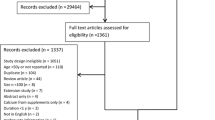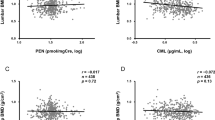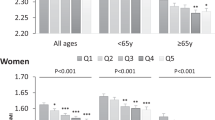Abstract
Background/Objectives:
In vitro studies demonstrate that bone is degraded in an acidic environment due to chemical reactions and through effects on bone cells. Clinical evidence is insufficient to unequivocally resolve whether the diet net acid or base load bone affects breakdown in humans. Increasing dietary salt (sodium chloride, NaCl) mildly increases blood acidity in humans and in rats with increased sensitivity to the blood pressure effects of salt, whereas increased potassium (K) intake can decrease blood pressure. Blood pressure responses to NaCl or K may potentially be a marker for increased bone turnover or lower bone mineral density (BMD) in women at higher risk for osteoporosis and fracture.
Subjects/Methods:
We retrospectively analysed data from two data sets (California and NE Scotland) of postmenopausal women (n=266) enrolled in long-term randomized, placebo-controlled studies of the effects of administration of low- or high-dose dietary K alkali supplementation on bone turnover in relation to sodium or chloride excretion (a marker of dietary salt intake). Mean arterial pressure (MAP) was calculated from blood pressure measures, MAP was divided into tertiles and its influence on the effect of dietary NaCl and K alkali supplementation on deoxypyridinoline markers of bone resorption and BMD by DEXA was tested. Data was analysed for each data set separately and then combined.
Results:
Percentage change in BMD after 24 months was less for California compared with North East Scotland (hip: −0.6±2.8% and −1.5±2.4%, respectively (P=0.027); spine: −0.5±3.4% and −2.6±3.5%, (P<0.001). We found no effect of dietary alkali treatment on BMD change or bone resorption for either centre. Adjusting for the possible calcium- or potassium-lowering effects on blood pressure did not alter the results.
Conclusions:
Blood pressure responses to Na, Cl or K intake did not help predict a BMD response to diet alkali therapy.
This is a preview of subscription content, access via your institution
Access options
Subscribe to this journal
Receive 12 print issues and online access
$259.00 per year
only $21.58 per issue
Buy this article
- Purchase on Springer Link
- Instant access to full article PDF
Prices may be subject to local taxes which are calculated during checkout



Similar content being viewed by others
References
Barrett-Connor E, Gore R, Browner WS, Cummings SR . Prevention of osteoporotic hip fracture: global versus high-risk strategies. Osteoporos Int 1998; 8: S2–S7.
Teucher B, Fairweather-Tait S . Dietary sodium as a risk factor for osteoporosis: where is the evidence? Proc Nutr Soc 2003; 62: 859–866.
Krieger NS, Frick KK, LaPlante Strutz K, Michalenka A, Bushinsky DA . Regulation of COX-2 mediates acid-induced bone calcium efflux in vitro. J Bone Miner Res 2007; 22: 907–917.
Bushinsky DA, Lechleider RJ . Mechanism of proton-induced bone calcium release: calcium carbonate-dissolution. Am J Physiol 1987; 53 (5 Pt 2), F998–1005.
Lutz J . Calcium balance and acid-base status of women as affected by increased protein intake and by sodium bicarbonate ingestion. Am J Clin Nutr 1984; 39: 281–288.
Lemann J, Litzow JR, Lennon EJ . The effects of chronic acid loads in normal man: further evidence for the participation of bone mineral in the defense against chronic metabolic acidosis. J Clin Invest 1966; 45: 1608–1614.
Sebastian A, Harris ST, Ottaway JH, Todd KM, Morris RC . Improved mineral balance and skeletal metabolism in postmenopausal women treated with potassium bicarbonate. N Engl J Med 1994; 330: 1776–1781.
Batlle DC, Sharma AM, Alsheikha MW, Sobrero M, Saleh A, Gutterman C . Renal acid excretion and intracellular pH in salt-sensitive genetic hypertension. J Clin Invest 1993; 91: 2178–2184.
Frings-Meuthen P, Baecker N, Heer M . Low-grade metabolic acidosis may be the cause of sodium chloride-induced exaggerated bone resorption. J Bone Miner Res 2008; 23: 517–524.
Fenton TR, Eliasziw M, Tough SC, Lyon AW, Brown JP, Hanley DA . Low urine pH and acid excretion do not predict bone fractures or the loss of bone mineral density: a prospective cohort study. BMC Musculoskelet Disord 2010; 11: 88–88.
Macdonald HM, Black AJ, Aucott L, Duthie G, Duthie S, Sandison R et al. Effect of potassium citrate supplementation or increased fruit and vegetable intake on bone metabolism in healthy postmenopausal women: a randomized controlled trial. Am J Clin Nutr 2008; 88: 465–474.
King JS, Jackson R, Ashe B . Relation of sodium intake to urinary calcium excretion. Invest Urol 1964; 1: 555–560.
McCarron DA, Rankin LI, Bennett WM, Krutzik S, McClung MR, Luft FC . Urinary calcium excretion at extremes of sodium intake in normal man. Am J Nephrol 1981; 1: 84–90.
Heaney RP . Role of dietary sodium in osteoporosis. J Am Coll Nutr 2006; 25: 271S–276S.
Aub JC, Tibbetts DM, McLean R . The influence of parathyroid hormone, urea, sodium chloride, fat and intertinal activity on calcium balance. J Nutr 1937; 113: 635–655.
Lin PH, Ginty F, Appel LJ, Aickin M, Bohannon A, Garnero P et al. The DASH diet and sodium reduction improve markers of bone turnover and calcium metabolism in adults. J Nutr 2003; 133: 3130–3136.
Zemel MB, Bedford BA, Standley PR, Sowers JR . Saline infusion causes rapid increase in parathyroid hormone and intracellular calcium levels. Am J Hypertens 1989; 2: 185–187.
Frassetto LA, Morris RC, Sebastian A . Dietary sodium chloride intake independently predicts the degree of hyperchloremic metabolic acidosis in healthy humans consuming a net acid-producing diet. Am J Physiol Renal Physiol 2007; 293: F521–F525.
Weinberger MH . Salt sensitivity of blood pressure in humans. Hypertension 1996; 27: 481–490.
Schmidlin O, Forman A, Leone A, Sebastian A, Morris RC . Salt sensitivity in blacks: evidence that the initial pressor effect of NaCl involves inhibition of vasodilatation by asymmetrical dimethylarginine. Hypertension 2011; 58: 380–385.
Morris RC, Sebastian A, Forman A, Tanaka M, Schmidlin O . Normotensive salt sensitivity: effects of race and dietary potassium. Hypertension 1999; 33: 18–23.
Houston MC . The importance of potassium in managing hypertension. Curr Hypertens Rep 2011; 13: 309–317.
Lin JS, O'Connor E, Whitlock EP, Beil TL . Behavioral counseling to promote physical activity and a healthful diet to prevent cardiovascular disease in adults: a systematic review for the U.S. Preventive Services Task Force. Ann Intern Med 2010; 153: 736–750.
Persy V, D'Haese P . Vascular calcification and bone disease: the calcification paradox. Trends Mol Med 2009; 15: 405–416.
D'Amelio P, Isaia G, Isaia GC . The osteoprotegerin/RANK/RANKL system: a bone key to vascular disease. J Endocrinol Invest 2009; 32 (4 Suppl), 6–9.
Schmidlin O, Leone A, Forman A, Sebastian A, Morris RC . Evidence that ADMA-mediated vascular dysfunction can initiate salt sensitivity in normotensive African Americans. Hypertension 2008; 52: E128.
Fang Y, Mu JJ, He LC, Wang SC, Liu ZQ . Salt loading on plasma asymmetrical dimethylarginine and the protective role of potassium supplement in normotensive salt-sensitive asians. Hypertension 2006; 48: 724–729.
Sharma AM, Kribben A, Schattenfroh S, Cetto C, Distler A . Salt sensitivity in humans is associated with abnormal acid-base regulation. Hypertension 1990; 16: 407–413.
Frassetto LA, Schmidlin O, Sebastian A . Sodium chloride sensitivity: a dual attack on blood pressure and bone. J Am Soc Nephrol 2009; 20: 759A.
Wimalawansa SJ . Rationale for using nitric oxide donor therapy for prevention of bone loss and treatment of osteoporosis in humans. Ann NY Acad Sci 2007; 1117: 283–297.
Nabhan AF, Rabie NH . Isosorbide mononitrate versus alendronate for postmenopausal osteoporosis. Int J Gynaecol Obstet 2008; 103: 213–216.
Jamal SA, Goltzman D, Hanley DA, Papaioannou A, Prior JC, Josse RG . Nitrate use and changes in bone mineral density: the Canadian Multicentre Osteoporosis Study. Osteoporos Int 2009; 20: 737–744.
Frassetto LA, Todd KM, Morris RC, Sebastian A . Estimation of net endogenous noncarbonic acid production in humans from diet potassium and protein contents. Am J Clin Nutr 1998; 68: 576–583.
Bingham SA, Gill C, Welch A, Cassidy A, Runswick SA, Oakes S et al. Validation of dietary assessment methods in the UK arm of EPIC using weighed records, and 24 hour urinary nitrogen and potassium and serum vitamin C and carotenoids as biomarkers. Intl J Epidemiol 1997; 26 (Suppl 1), S137–S151.
Day N, McKeown N, Wong M, Welch A, Bingham S . Epidemiological assessment of diet: a comparison of a 7-day diary with a food frequency questionnaire using urinary markers of nitrogen, potassium and sodium. Intl J Epidemiol 2001; 30: 309–317.
McKeown NM, Day NE, Welch AA, Runswick SA, Luben RN, Mulligan AA et al. Use of biological markers to validate self-reported dietary intake in a random sample of the European prospective investigation into Cancer United Kingdom Norfolk Cohort. Am J Clin Nutr 2001; 74: 188–196.
MacDonald AG, Birkinshaw G, Durham B, Bucknall RC, Fraser WD . Biochemical markers of bone turnover in seronegative spondylarthropathy: relationship to disease activity. Br J Rheumatol 1997; 36: 50–53.
Macdonald HM, Hardcastle AC, Duthie GG, Duthie SJ, Aucott L, Sandison R et al. Changes in vitamin biomarkers during a 2-year intervention trial involving increased fruit and vegetable consumption by free-living volunteers. Br J Nutr 2009; 102: 1477–1486.
Frassetto L, Morris RCJ, Sebastian A . Long-term persistence of the urine calcium-lowering effect of potassium bicarbonate in postmenopausal women. J Clin Endocrinol Metab 2005; 90: 831–834.
Cummings SR, Block G, McHenry K, Baron RB . Evaluation of two food frequency methods of measuring dietary calcium intake. Am J Epidemiol 1987; 126: 796–802.
Remer T, Manz F . Estimation of the renal net acid excretion by adults consuming diets containing variable amounts of protein. Am J Clin Nutr 1994; 59: 1356–1361.
Sellmeyer DE, Stone KL, Sebastian A, Cummings SR . A high ratio of dietary animal to vegetable protein increases the rate of bone loss and the risk of fracture in postmenopausal women. Study of Osteoporotic Fractures Research Group. Am J Clin Nutr 2001; 73: 118–122.
Dawson-Hughes B, Harris SS, Palermo NJ, Castaneda-Sceppa C, Rasmussen HM, Dallal GE . Treatment with potassium bicarbonate lowers calcium excretion and bone resorption in older men and women. J Clin Endocrinol Metab 2009; 94: 96–102.
J Jehle S, Zanetti A, Muser J, Hulter HN, Krapf R . Partial neutralization of the acidogenic Western diet with potassium citrate increases bone mass in postmenopausal women with osteopenia. J Am Soc Nephrol 2006; 17: 3213–3222.
Sellmeyer DE, Schloetter M, Sebastian A . Potassium citrate prevents increased urine calcium excretion and bone resorption induced by a high sodium chloride diet. J Clin Endocrinol Metab 2002; 87: 2008–2012.
Jehle S, Krapf R . Long term neutralization of diet-induced acid load by K citrate increases bone density in elderly subjects with normal bone mass: Results of a 2 year placebo controlled trial. J Am Soc Nephrol 2010; 21: 36 (F-FC2).
Darling AL, Millward DJ, Torgerson DJ, Hewitt CE, Lanham-New SA . Dietary protein and bone health: a systematic review and meta-analysis. Am J Clin Nutr 2009; 90: 1674–1692.
Fenton TR, Tough SC, Lyon AW, Eliasziw M, Hanley DA . Causal assessment of dietary acid load and bone disease: a systematic review & meta-analysis applying Hill's epidemiologic criteria for causality. Nutr J 2011; 10: 41.
Fenton TR, Lyon AW, Eliasziw M, Tough SC, Hanley DA . Meta-analysis of the effect of the acid-ash hypothesis of osteoporosis on calcium balance. J Bone Miner Res 2009; 24: 1835–1840.
Chen J . Sodium sensitivity of blood pressure in Chinese populations. Curr Hypertens Rep 2010; 12: 127–134.
von Muhlen D, Safii S, Jassal SK, Svartberg J, Barrett-Connor E . Associations between the metabolic syndrome and bone health in older men and women: the Rancho Bernardo Study. Osteoporos Int 2007; 18: 1337–1344.
Li J, White J, Guo L, Zhao X, Wang J, Smart EJ et al. Salt inactivates endothelial nitric oxide synthase in endothelial cells. J Nutr 2009; 139: 447–451.
Kasten TP, Collin-Osdoby P, Patel N, Osdoby P, Krukowski M, Misko TP et al. Potentiation of osteoclast bone-resorption activity by inhibition of nitric oxide synthase. Proc Natl Acad Sci USA 1994; 91: 3569–3573.
Lowik CW, Nibbering PH, van de Ruit M, Papapoulos SE . Inducible production of nitric oxide in osteoblast-like cells and in fetal mouse bone explants is associated with suppression of osteoclastic bone resorption. J Clin Invest 1994; 93: 1465–1472.
Krishna GG . Effect of potassium intake on blood pressure. J Am Soc Nephrol 1990; 1: 43–52.
Allender PS, Cutler JA, Follmann D, Cappuccio FP, Pryer J, Elliott P . Dietary calcium and blood pressure: a meta-analysis of randomized clinical trials. Ann Intern Med 1996; 124: 825–831.
Jurgens G, Graudal NA . Effects of low sodium diet versus high sodium diet on blood pressure, renin, aldosterone, catecholamines, cholesterols, and triglyceride. Cochrane Database Syst Rev 2003 (1): CD004022.
Garnero P . Biomarkers for osteoporosis management: utility in diagnosis, fracture risk prediction and therapy monitoring. Mol Diagn Ther 2008; 12: 157–170.
Acknowledgements
This work was funded in part by the UK Food Standards Agency (UK) and in part by Armand Hammer (USA).
Author contributions
Analytical design: AH, HM, LF, AS. Data analyses: AH. Data interpretation: AH, HM, LF, AS. Drafting manuscript: HM, LF, AS, AH. Revising manuscript content: all. Approving final version of manuscript: all. Integrity of the data analyses: AH, HM, LF.
Author information
Authors and Affiliations
Corresponding author
Ethics declarations
Competing interests
The authors declare no conflict of interest.
Rights and permissions
About this article
Cite this article
Frassetto, L., Hardcastle, A., Sebastian, A. et al. No evidence that the skeletal non-response to potassium alkali supplements in healthy postmenopausal women depends on blood pressure or sodium chloride intake. Eur J Clin Nutr 66, 1315–1322 (2012). https://doi.org/10.1038/ejcn.2012.151
Received:
Revised:
Accepted:
Published:
Issue Date:
DOI: https://doi.org/10.1038/ejcn.2012.151
Keywords
This article is cited by
-
Food fortification for bone health in adulthood: a scoping review
European Journal of Clinical Nutrition (2016)
-
The effect of supplementation with alkaline potassium salts on bone metabolism: a meta-analysis
Osteoporosis International (2015)
-
Dietary Approaches for Bone Health: Lessons from the Framingham Osteoporosis Study
Current Osteoporosis Reports (2015)
-
The acid–ash hypothesis revisited: a reassessment of the impact of dietary acidity on bone
Journal of Bone and Mineral Metabolism (2014)



